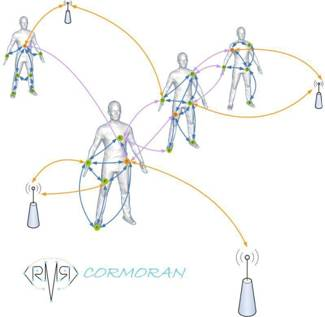May 31 2013
CEA-Leti today announced it is coordinating the multi-partner CORMORAN project focusing on new forms of cooperation in and between wireless body area networks. Targeted applications include coordinated navigation of groups in buildings or large-scale motion capture for gaming, sports and healthcare.
 New joint functions of communication and radiolocation, designed to exploit cooperative, low data rate radio links between sensors, on the body and/or between mobile users.
New joint functions of communication and radiolocation, designed to exploit cooperative, low data rate radio links between sensors, on the body and/or between mobile users.
Wireless body area networks (WBANs), consisting of wearable sensors or devices, already are being commercialized in emerging markets as diverse as security, rescue, health, gaming or intelligent clothing. If deployed in very large segments of the population, they might eventually be a key component of the Internet of Things (IoT) and form the skeleton of future distributed cooperative communication networks for mobile-device users.
Protocols for communication and localization, adapted to individual and/or collective behavior of humans in movement (i.e. including biomechanical and social mobility aspects) can therefore utilize new forms of cooperation within and between these body sensor networks.
The CORMORAN project, funded by the French National Research Agency, is specifically investigating new mechanisms that allow WBANs to work more efficiently at the body scale, while also interacting and cooperating with other similar networks. The coexistence of groups of equipped users can cause radio interference, but it is also a beneficial source of information redundancy and/or diversity through cooperation. The latter enables optimal data relaying or routing, and mitigation of packets’ losses or body obstructions, and supplies sufficiently large series of independent radiolocation measurements.
Determining the proper level and modalities of such cooperation thus helps to optimize the quality of communications in and between WBANs, as well as to opportunistically locate radio devices relative to the body or even users carrying them in a building, for example. In addition to overcoming severe constraints on power consumption and radiated power, the partners have also integrated in their investigations WBAN-specific constraints such as short transmission ranges, finite network topologies or periodic radio obstructions due to body shadowing or human movement patterns.
To permit multi-standard WBAN deployment (i.e. involving simultaneous on-body, off-body and body-to-body links), project partners are investigating both low-data rate and low-power wireless technologies, including impulse radio ultra-wideband (IR-UWB) or narrow-band radio systems centered on 2.4GHz (ZigBee, Bluetooth - low energy etc.).
Based on a detailed modeling of these heterogeneous wireless resources, the CORMORAN project will identify the different layers of a communication protocol suitable for the new cooperative functionalities, including synchronization issues, radio channel access and networking, and management of coexistence, or radiolocation, algorithms. With its multidisciplinary approach, CORMORAN will address theoretical aspects, such as modeling radio metrics and physical mobility, and design of algorithms and protocols. More practical aspects include characterization of the propagation channel and on-body antennas, development of adapted cross-layer simulation tools and field experiments based on real radio platforms.
The CORMORAN consortium includes four research laboratories with complementary strengths and proven experience in the areas of wireless sensor networks and radiolocation: CEA-Leti (coordinator), INSA de Lyon-CITI, ISIC Telecom ParisTech–LINCS, and University of Rennes 1-IETR.